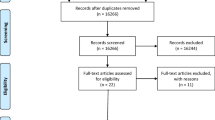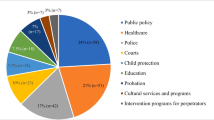Abstract
Objectives
The development and application of methods to assess consistency in sentencing before and after the 2011 England and Wales assault guideline came into force.
Methods
We use the Crown Court Sentencing Survey to compare the goodness of fit of two regression analyses of sentence length on a set of legal factors before and after the assault guideline came into force. We then monitor the dispersion of residuals from these regressions models across time. Finally, we compare the variance in sentence length of equivalent types of offences using exact matching.
Results
We find that legal factors can explain a greater portion of variability in sentencing after the guideline was implemented. Furthermore, we detect that the unexplained variability in sentencing decreases steadily during 2011, while results from exact matching point to a statistically significant average reduction in the variance of sentence length amongst same types of offences.
Conclusions
We demonstrate the relevance of two new methods that can be used to produce more robust assessments regarding the evolution of consistency in sentencing, even in situations when only observational non-hierarchical data is available. The application of these methods showed an improvement in consistency during 2011 in England and Wales, although this positive effect cannot be conclusively ascribed to the implementation of the new assault guideline.



Similar content being viewed by others
Notes
The new assault guidelines can be downloaded from: http://sentencingcouncil.judiciary.gov.uk/docs/Assault_definitive_guideline_-_Crown_Court.pdf.
The professional consultation can be downloaded from: http://sentencingcouncil.judiciary.gov.uk/docs/ASSAULT_Professional_web.pdf.
The old assault guideline can be downloaded from: http://webarchive.nationalarchives.gov.uk/20100305172947/http://www.sentencing-guidelines.gov.uk/guidelines/council/final.html.
The newsletter can be downloaded from this link: http://www.bbc.co.uk/news/uk-12681250.
Students of sentencing reform have recognised the need for more and better research to evaluate how well these reforms have reduced unwarranted disparity (Hofer et al. 1999, p. 262).
[…] such research has been rife with methodological limitations not least of which is the failure to quantify or appropriately define disparity. This calls into question the true level of disparity within the system (Casey and Wilson 1998, p. 237).
See Pina-Sánchez and Linacre (2013) for a description of how measures of inconsistency from random slopes are less prone to problems of omitted relevant variables.
See Roberts (2013a), and the Guide to CCSS Statistics for more information on the CCSS. The latter can be found here, http://sentencingcouncil.judiciary.gov.uk/docs/Guide_to_CCSS_Statistics.pdf.
E.g. In 2012 the British Attitudes Survey and Labour Force Survey achieved a response rate of 54 and 48 %, respectively.
See Rubin (1987) for a classification of the implications and possible adjustments for the different missing data mechanisms.
This was due to administrative difficulties in ensuring that introduction of new forms into courts coincided with the date the new guideline came into effect.
The CCSS questionnaire also considers a category for ten or more previous convictions, but the sample used here does not capture subjects with that value. These are more common in more recidivistic offences such as theft.
The statistical modelling presented in this paper was carried out in R. For robust SEs we used the sandwich estimator, from the sandwich package.
This change of R2 in addition to the previous changes for the coefficients of GBH, intent, and previous convictions, were found to be statistically significant using a Chow test, with a p value >.001.
See also Keele (2008) for an excellent review of semi and non-parametric regression methods.
Under the dispersion of residuals methodology a linear regression model has to be formulated to specify the mathematical relationship between legal factors and sentence length. Although this model allows considerable flexibility in specifying functional form, it can only ever provide an approximation to the true empirical relationship.
The number of matched groups and their sample size are shown in Appendix 2.
The characteristics used to define the 10 matches, and their before and after variances are presented in Appendix 3.
References
Anderson A, Spohn C (2011) Lawlessness in the federal sentencing process: a test for uniformity and consistency in sentence outcomes. Justice Q 27:362–393
Anderson J, Kling J, Stith K (1999) Measuring inter-judge sentencing disparity: before and after the federal sentencing guidelines. J Law Econ 42:271–307
Ashworth A, Roberts J (2013) The origins and nature of the sentencing guidelines in England and Wales. In: Ashworth A, Roberts J (eds) Sentencing guidelines: exploring the english model. Oxford University Press, Oxford, pp 1–12
Brantingham P (1985) Sentencing disparity: an analysis of judicial consistency. J Quant Criminol 1:281–305
Casey J, Wilson J (1998) Discretion, disparity or discrepancy? A review of sentencing consistency. Psychiatry Psychol Law 5:237–247
Cleveland WS (1979) Robust locally weighted regression and smoothing scatterplots. J Am Stat Assoc 74:829–836
Dhami MK (2013) A “Decision Science” perspective on the old and new sentencing guidelines in England and Wales. In: Ashworth A, Roberts J (eds) Sentencing guidelines: exploring the english model. Oxford University Press, Oxford, pp 165–181
Frase RS (2005) Sentencing guidelines in Minnesota, 1978–2003. Crime Justice 32:131–219
Hofer P, Blackwell K, Ruback RB (1999) The effect of the federal sentencing guidelines on inter-judge sentencing disparity. J Crim Law Criminol 90:239–321
Hutton N (2013) The definitive guideline on assault offences issued by the sentencing council for England and Wales. In: Ashworth A, Roberts J (eds) Sentencing guidelines: exploring the english model. Oxford University Press, Oxford, pp 86–103
Keele L (2008) Semiparametric regression for the social sciences. Wiley, Chichester
Kramer J, Ulmer J (2002) Downward departures for serious violent offenders: local court “Corrections” to Pennsylvania’s sentencing guidelines. Criminology 40:807–932
Lovegrove A (1984) An empirical study of sentencing disparity among judges in an Australian criminal court. Inter Rev Appl Psychol 33:161–176
Mason T, de Silva N, Sharma N, Brown D, Harper G (2007) Local variation in sentencing in England and Wales. Ministry of Justice, London
Minnesota Sentencing Guidelines Commission (2012) Sentencing practices: controlled substance offenses sentenced in 2010. http://www.leg.state.mn.us/docs/2013/other/130860.pdf
Orchard N, Howlett J, Davies E, Pearson G, Payne A (1997) Does inter-judge disparity really matter? an analysis of the effects of sentencing reforms in three federal district courts. Inter Rev Law Econ 17:337–366
Oregon Criminal Sentencing Commission (2003) Sentencing practices: summary statistics for felony offenders sentenced in 2001. http://www.oregon.gov/CJC/docs/SG01v2.pdf
Pina-Sánchez J, Linacre R (2013) Sentence consistency in England and Wales: evidence from the crown court sentencing survey. Br J Criminol 53:1118–1138
Roberts J (2012) Structured sentencing: lessons from England and Wales for common law jurisdictions. Punishm Soc 14:267–288
Roberts J (2013a) Complying with sentencing guidelines: latest findings from the crown court sentencing survey. In: Ashworth A, Roberts J (eds) Sentencing guidelines: exploring the english model. Oxford University Press, Oxford, pp 104–121
Roberts J (2013b) Sentencing guidelines in England and Wales: recent developments and emerging issues. Law Contemp Probl 76:1–26
Rubin D (1987) Multiple imputation for nonresponse in surveys. Wiley, New York
Scott R (2010) Inter-judge sentencing disparity after booker: a first look. Express, http://works.bepress.com/ryan_scott/2/
Sentencing Commission Working Group (2008) Sentencing guidelines in England and Wales: an evolutionary approach. SCWG, London
Sentencing Guidelines Council (2008) Assault and other offences against the person. Definitive guideline. http://webarchive.nationalarchives.gov.uk/20100305172947/http://www.sentencing-guidelines.gov.uk/docs/assault-against-the%20person.pdf
Sentencing Council (2011) Assault guideline—professional consultation. http://sentencingcouncil.judiciary.gov.uk/docs/ASSAULT_Professional_web.pdf
Tarling R (2006) Sentencing practice in magistrates’ courts revisited. Howard J 45:29–41
Tonry MH (1987) Sentencing reform impacts. National Institute of Justice, Rockville
Tonry MH (1996) Sentencing Matters. Oxford University Press, New York
Ulmer J, Light M, Kramer J (2011) The “Liberation” of federal judges’ discretion in the wake of the Booker/Fanfan decision: is there increased disparity and divergence between courts? Justice Q 28:799–837
Waldfogel J (1991) Aggregate inter-judge disparity in federal sentencing: evidence from three districts. Fed Sentencing Report 4:151–154
Walker T, Sager T (1991) Are the federal sentencing guidelines meeting congressional goals: an empirical and case law analysis. Emory Law J 40:393–444
Author information
Authors and Affiliations
Corresponding author
Additional information
Disclaimer
The views expressed in this paper are those of the authors and do not necessarily represent the views of the Sentencing Council for England and Wales.
Appendices
Appendix 1: Descriptive Statistics of the Variables Used
Variable | Mean: before | Mean: after | SD: before | SD: after |
|---|---|---|---|---|
Log sentence length | 6.11 | 6.25 | .78 | .85 |
Previous convictions | 2.04 | 1.55 | .71 | .50 |
First opportunity | .22 | .30 | .42 | .46 |
Remorse | .34 | .29 | .47 | .45 |
Carer | .05 | .02 | .22 | .14 |
Gang | .20 | .08 | .40 | .27 |
Vulnerable | .15 | .10 | .36 | .30 |
Public officer | .04 | .04 | .21 | .20 |
Sustained | .30 | .32 | .46 | .47 |
Drugs | .35 | .35 | .48 | .48 |
ABH | .53 | .48 | .50 | .50 |
GBH | .31 | .31 | .46 | .46 |
GBH with intent | .15 | .21 | .36 | .41 |
Appendix 2: Matched Groups Ordered by Sample Size

Appendix 3: Top Ten Largest Matched Groups
Type of offence | Previous convictions | Aggravating/mitigating | Group size: before | Group size: after | Variance: before | Variance: after | Variance difference |
|---|---|---|---|---|---|---|---|
ABH | 0 | – | 112 | 112 | .37 | .42 | −.05 |
ABH | 1–3 | – | 141 | 89 | .36 | .30 | .05 |
GBH | 1–3 | – | 78 | 74 | .21 | .24 | −.03 |
GBH | 0 | – | 60 | 59 | .32 | .24 | .08 |
ABH | 1–3 | Sustained | 40 | 51 | .50 | .34 | .16 |
GBH | 1–3 | Drugs | 48 | 37 | .23 | .32 | −.08 |
ABH | 1–3 | Drugs | 62 | 35 | .28 | .20 | .08 |
Intent | 1–3 | – | 33 | 33 | .30 | .14 | .16 |
ABH | 1–3 | First op. | 34 | 28 | .55 | .32 | .23 |
GBH | 1–3 | Remorse | 28 | 28 | .13 | .24 | −.11 |
Appendix 4: Monte Carlo Simulation
Our approach to determine whether the change in the groups weighted variance is statistically significant involved four steps: (1) the simulation of a new dataset of sentence lengths with the number of groups and cases per group corresponding to our CCSS data. Simulations are drawn from different normal distributions for each group with mean of zero and variance determined by s 2 B,k ; (2) the statistic presented in Eq. (3) is calculated using the simulated dataset; (3) steps 1 and 2 are iterated 10,000 times so a sampling distribution of test statistics can be constructed; (4) the estimate of from Eq. (3) using the real data is compared to the 5th percentile of the simulated sampling distribution, and if the former is smaller we can say that the reduction in the variance after the new guideline came into force is statistically significant.
In Fig. 4 we show the simulated sampling distribution together with two vertical lines: a continuous red line signalling the 5th percentile at .927 and a black dashed line indicating the value of our test statistics at .923. Since the latter is smaller than the former we can claim that the observed reduction of the aggregated group variance after the new guideline came into force is statistically significant.
Rights and permissions
About this article
Cite this article
Pina-Sánchez, J., Linacre, R. Enhancing Consistency in Sentencing: Exploring the Effects of Guidelines in England and Wales. J Quant Criminol 30, 731–748 (2014). https://doi.org/10.1007/s10940-014-9221-x
Published:
Issue Date:
DOI: https://doi.org/10.1007/s10940-014-9221-x





